
by Mary Caperton Morton Thursday, May 24, 2018
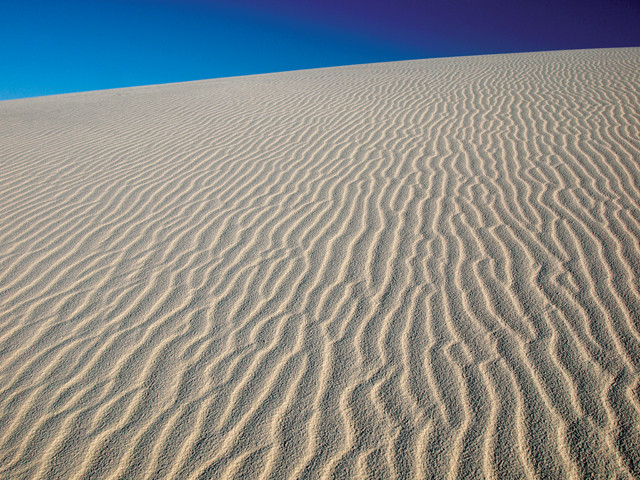
Saltation of sand grains blown by wind creates a ripple pattern on the surface of the dunes. Credit: Mary Caperton Morton
The Desert Southwest is famous for out-of-this-world landscapes — some places look like the moon, others like Mars — but New Mexico’s White Sands National Monument, at the very northern end of the Chihuahuan Desert, offers an otherworldly backdrop like no other.
Here, exotic oryx wander the brilliantly pale desert, dodging missiles in the active bombing range to the north that is home to the Trinity Site, where the world’s first atomic bomb was detonated in 1945. The southern portion of the dune field, designated a national monument in 1933, boasts some of the world’s shiftiest dunes and a unique desert ecology that make White Sands one of the planet’s most fascinating sandboxes.
Gypsum, Gypsum Everywhere
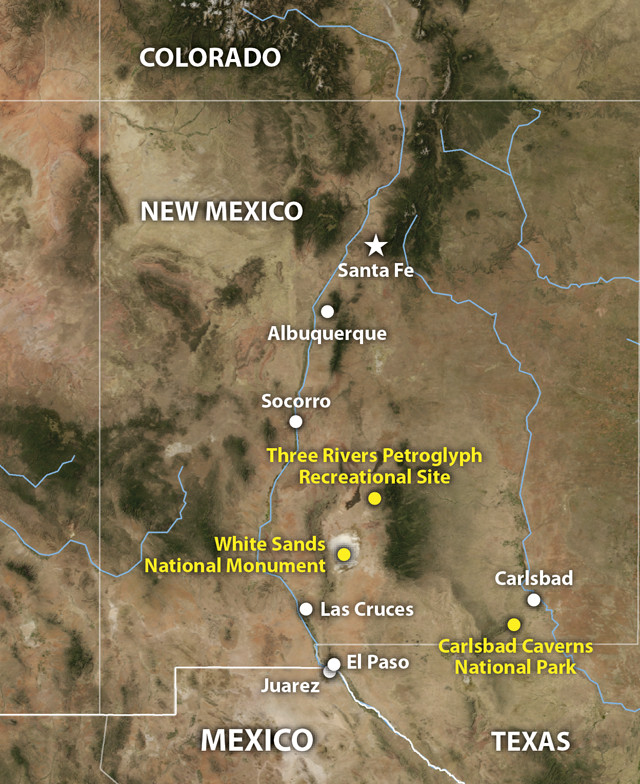
Credit: Kat Cantner, AGI
The area’s signature stark white powder isn’t your typical sand — the silica- or carbonate-based stuff that makes up beaches and dunes all over the world. It’s actually gypsum — hydrous calcium sulfate — born as evaporite deposits and eventually ground down by the wind to sugar-fine sand.
The White Sands gypsum was originally deposited 250 million years ago in a shallow sea covering the region of the supercontinent Pangaea that is now the American Desert Southwest. About 70 million years ago, the gypsum-rich deposits — mainly found in the 450-meter-thick Yeso formation (Yeso is Spanish for gypsum) — were uplifted into a dome during a mountain-building episode known as the Laramide orogeny, which also raised the Rocky Mountains. Then, about 10 million years ago, crustal extension along the Rio Grande Rift caused the dome to collapse, eventually creating the Tularosa Basin, which surrounds White Sands. A glimpse of the original dome is preserved in the mountain ranges that ring White Sands: the San Andres Mountains to the west and the Sacramento Mountains to the east.
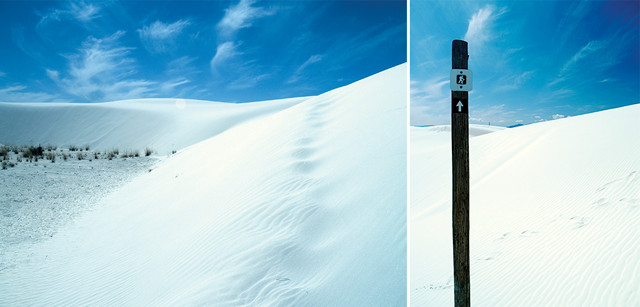
Hiking in the dunes of White Sands can be disorienting. Credit: Mary Caperton Morton
The gypsum that makes up the dunes of White Sands doesn’t come directly from the mountains; it is first dissolved and transported, recrystallized as selenite and then eroded into sand by the wind. Selenite crystals are mainly found at Lake Otero, a former glacial lake now reduced to a vast arid playa, and Lake Lucero in the farthest southwest corner of the park. Lucero is usually dry, but it occasionally contains water after late summer storms drop most of the region’s meager 23 centimeters of annual rainfall. Very few new crystals form today, but wind-driven erosion of the lake sediments and existing crystals continue to supply new sand.
Gypsum sand is relatively rare because it is water soluble and easily dissolved. Because the Tularosa Basin is fully enclosed, little gypsum is lost over time: The limited moisture that falls as rain or snow is trapped in the basin, where it evaporates and leaves behind any dissolved gypsum in the form of selenite crystals, some over a meter long.
White-Washed Dunes
Dunes begin at Lake Lucero and move northeast, driven by relentless winds from the southwest. Wind drives the gypsum particles up the backsides of the dunes, creating ripples on their surface. At the dune’s steep leading edge, the particles build up until gravity pulls them down the slip face, thus advancing the dune forward. The dune fields at White Sands are some of the most active in the world, with some formations moving as much as 100 meters per year.
Four different types of dunes are found at White Sands — dome, crescent, parabolic and transverse — each reflecting a different formation mechanism. Dome dunes form along the leeward shores of Lake Lucero. Crescent dunes form in windy areas and are the fastest-moving dunes in the park. Parabolic dunes, the slowest-moving variety, are generally found along the perimeter of the dune field in areas with the least loose sand. Transverse dunes form in areas with large amounts of loose sand, stretching into long, wavy ridges.
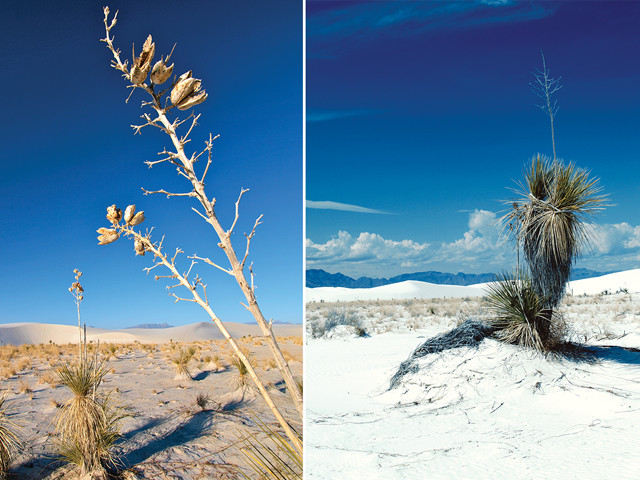
Yucca provides valuable habitat for desert dwellers. Credit: Mary Caperton Morton
This cycle of erosion, evaporation and dune building dates back 6,500 years, after Lake Otero dried up following the end of the last glacial period, making White Sands a relatively young geologic feature. Today, White Sands boasts the largest gypsum field in the world, stretching more than 700 square kilometers. Whether the continuously migrating dune field is growing or shrinking in area is unknown.
White Flora and Fauna
It might seem impossible that plants and animals can eke out a living in such a stark environment, but White Sands is full of life. Most of the park’s wild residents are best viewed in the early morning, late evening or after dark, when they are most active, though some are well camouflaged: Three species of lizards, one mouse, and several species of insects, scorpions and spiders have evolved white colorations to blend in with the environment.
During the heat of the day — summertime temperatures can soar to over 36 degrees Celsius — snakes, rodents, foxes, bobcats, coyotes, mule deer, opossums, porcupines and jackrabbits usually lay low. The largest denizens of the dunes are wild oryx, a large antelope imported from Africa in 1969 for hunting by the New Mexico Department of Game and Fish. Native to the Kalahari, oryx are well adapted to desert life, and with no natural predators (they are hunted by lions in Africa) or competition, the oryx quickly multiplied and became a pest. Annual hunts keep the population in check, but in 1996, a 100-kilometer-long fence was built to keep the 450-pound grazers out of the national monument.
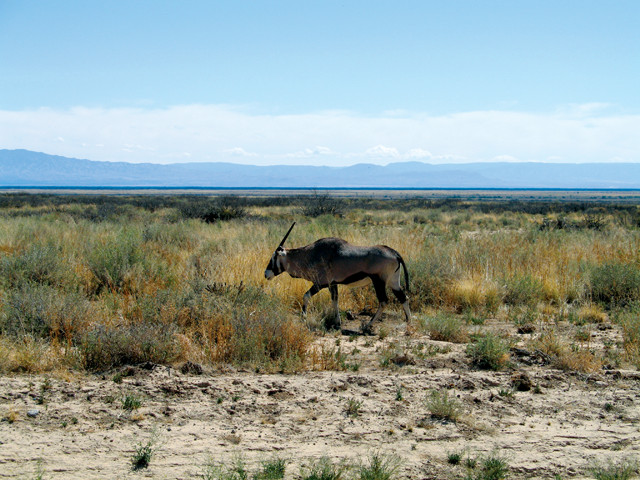
Oryx, native to the Kalahari, were imported in 1969 by the New Mexico Department of Game and Fish for hunting. Credit: ©Chris Short, Creative Commons Attribution-ShareAlike 2.0 Generic
Plants have to be especially hardy to survive in White Sands, as constantly shifting dunes can easily overwhelm root systems. The most common flora are yucca, which grow fast and tolerate long periods of drought. Yucca provide prime habitat for creatures, which seek shelter in the plant’s fibers, and animal and insect tracks can usually be found around the bases of these desert sentinels.
Visiting the Trinity Site
On July 16, 1945, the world’s first atomic bomb was detonated in the northern section of the White Sands Missile Range at the Trinity Site. Today, the bombing range is still active and closed to the public 363 days a year. Twice annually, on the first Saturdays in April and October, the bombing range holds an open house for the public to visit the Trinity Site and the McDonald Ranch House, where the plutonium core of the bomb was assembled.
There is usually a large public turnout for the event, which can get crowded with thousands of people by afternoon. It’s best to stay nearby in Socorro or just down the road at the Valley of Fires Recreation Area and get to the gates on Stallion Road, off highway 380, at first light. You’ll need to show ID and abide by a list of rules, including no photography on base until you get to the Trinity Site, no political demonstrations or protests, and no weapons or alcohol.
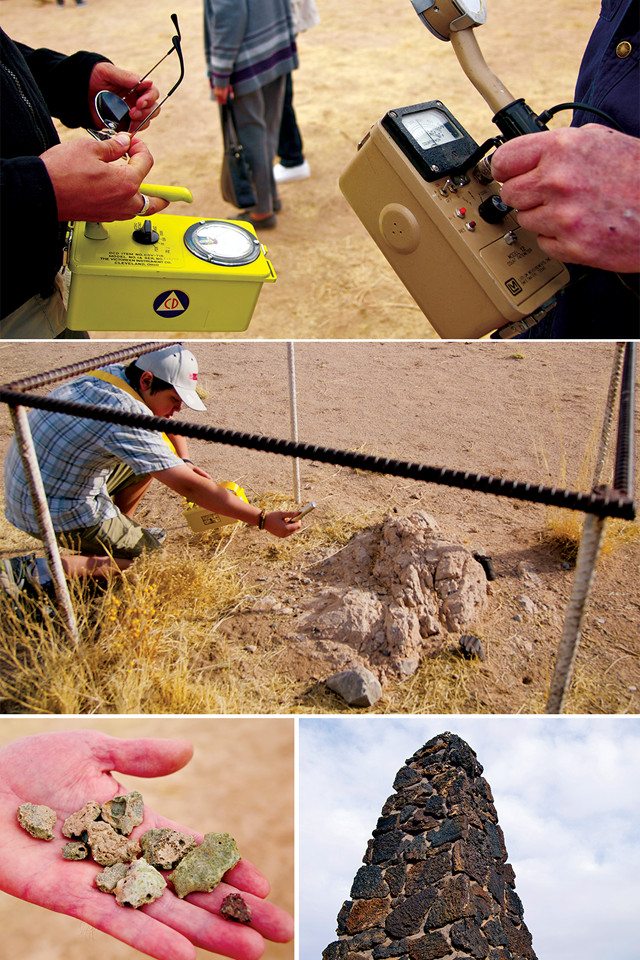
Visiting the Trinity Site, where the world's first atomic bomb was detonated in July 1945. Top to bottom: Visitors often carry around Geiger counters to measure radiation as they walk through the site; background radiation levels at the site aren't dangerously high; (bottom left) trinitite, a glassy green rock created by the shockwave of the atomic blast, is found at the site, but note that removing pieces is strictly forbidden; (bottom right) an obelisk marks "ground zero" of the detonation.
Before every open house, radiation levels at the Trinity Site area are measured by an independent team of consultants. Levels have tapered off considerably since 1945, with ground zero averaging about 10 times the natural background levels of radiation for the region. A one-hour visit to the site typically results in an exposure of 0.5 to 1 millirem, or about half the radiation exposure of a cross-country flight.
One of the highlights of visiting the ground zero site — a 100-meter-diameter slight depression in the land marked by an obelisk and surrounded by a chain link fence — is the trinitite: a glassy green rock created by the shockwave of the blast. Walk around the site, keeping an eye out for a rock unlike anything you’ve seen before and you’ll be sure to spot some, though tons have been hauled away by researchers and sticky-fingered collectors. Note that removing pieces of trinitite is strictly forbidden.
Playing in the Great White Sandbox
Hiking in White Sands can be exhausting and disorienting, but the exotic landscape is well worth the effort. The easily dissolved gypsum particles are well cemented below the surface of the dunes, making the dunes easier to ascend than looser quartz-sand dunes. And unlike beach sand, the highly reflective bright white gypsum sands do not get scorching hot in the sun and can usually be traversed barefoot, even on the hottest days.
Experienced desert hikers can strike off into the dunes on their own, but backcountry hikers should remain vigilant of landmarks and carry a compass; it’s very easy to get turned around and disoriented in the dunes. The park also offers a few well-marked nature trails as well as free ranger-led group hikes. Sunset and sunrise on the white dunes are especially striking, and photographers will have a field day capturing the unique monochromatic landscape. Sand sledding on the dunes is popular with both kids and adults. The visitor center rents saucers, which work best on the dunes.
With its vast gypsum field, ever-shifting bright white dunes and infamous atomic history, White Sands is certainly a unique desert destination. The next open houses for the Trinity Site are Oct. 5, 2013, and April 5, 2014, and White Sands National Monument is open every day, year round, though in the summer months the area can be unbearably hot. Start planning your trip now for this fall, winter or next spring and you’ll be rewarded with a surreal romp in one of the world’s most striking sandboxes.
© 2008-2021. All rights reserved. Any copying, redistribution or retransmission of any of the contents of this service without the expressed written permission of the American Geosciences Institute is expressly prohibited. Click here for all copyright requests.